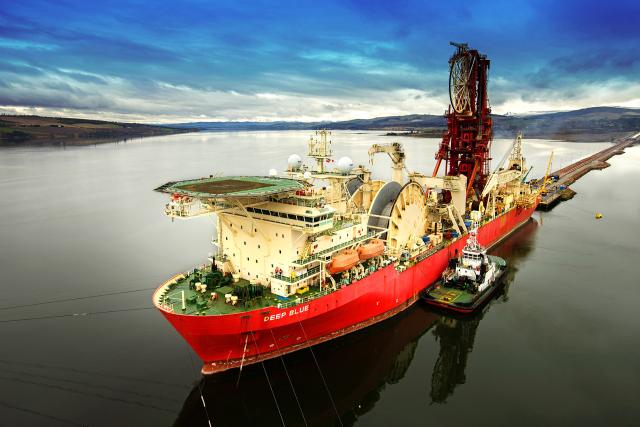
The Deep Blue continues to rack up a track record of achievements. (Source: Technip)
After 15 years as the much-vaunted flagship of Technip’s pipelay and subsea construction fleet, the Deep Blue is still racking up a track record of achievements that leaves most of its rivals in its wake.
Since coming onto the market in 2001 the versatile vessel has been responsible for setting plenty of offshore records, thanks to its ability to carry out reel-lay, J-lay and flexi-lay operations globally. Technip’s claims at the time of its launch of the ship being able to support development operations in water depths of up to 3,000 m (9,843 ft) have been fully put to the test and fully proven.
Most recently, it has been working on Shell’s record-breaking Stones Field in the U.S. Gulf of Mexico (GoM), which will come onstream later this year and become the world’s deepest producing floating facility.

Water depth record
The French contractor was first awarded a contract in 2013 for the Deep Blue to install subsea infrastructure on Stones in the Walker Ridge area of the GoM in a water depth of about 2,900 m (9,500 ft). That work, laying the world’s deepest gas pipeline, was done in second-half 2014, while Technip also won another award last year for subsea infrastructure, which saw the Deep Blue install more hardware in a water depth of 2,930 m (9,613 ft). The installation of the subsea production system was carried out in February this year.
The dynamically positioned vessel is next due to carry out more installation work this summer when it starts work on Deep Gulf Energy II’s Odd Job Field in the Mississippi Canyon area in water depths ranging from 1,330 m to 1,825 m (4,364 ft to 5,988 ft). The workscope includes installing about 23 km (14 miles) of pipe-in-pipe flowline, 2 km (1 mile) of steel catenary riser, and in-line sled and flowline end terminations.
The Deep Blue’s Stones work doesn’t quite beat the vessel’s current depth record, when in 2009 it installed reeled pipe for Shell’s Perdido development in the GoM in 2,957 m (9,701 ft) of water. Other records it holds include installing the deepest pipe-in-pipe reel-lay, again for Shell on its Na Kika Field in the GoM in 2,115 m (6,940 ft) of water in 2005.
Still of note within the pipelay market is its ultradeepwater ability to lay both flexible (up to a 24-in. outer diameter [OD]) and rigid reeled lines (4-in. to 18-in. overall diameter), with 550 mt of tensioning capacity, while in J-lay mode it can lay lines of up to a 28-in. OD with 770 mt of tensioning capacity.
Recommended Reading
ChampionX’s Aerial Optical Gas Imaging Platform Secures EPA Approval
2025-03-05 - ChampionX Corp.’s aerial optical gas imaging platform combines optical technology with a gimbal system to detect and locate methane leaks.
LongPath Ditches Up-in-the-Air Tech for Emissions Reduction Closer to Ground
2024-12-17 - LongPath Technologies has received a federal loan to develop a monitoring network and conditional approval from the state of New Mexico for use of its system at oil and gas operations.
Baker Hughes, Woodside Partner to Scale Net Power Platform
2025-03-06 - Net Power’s platform uses natural gas to generate power while capturing nearly all CO2 emissions, Baker Hughes said in a news release.
Montana Renewables Closes $1.44B DOE Loan for Facility Expansion
2025-01-13 - The expansion project will lift annual production capacity to about 300 million gallons of sustainable aviation fuel (SAF) and 330 million gallons of combined SAF and renewable diesel.
Equigas, CO2Meter to Partner in Offering Gaslab Detection Devices
2025-02-14 - The devices are used in industrial operations to monitor gas leaks and maintain air quality and safety compliance.
Comments
Add new comment
This conversation is moderated according to Hart Energy community rules. Please read the rules before joining the discussion. If you’re experiencing any technical problems, please contact our customer care team.





